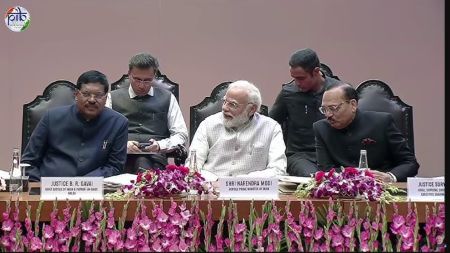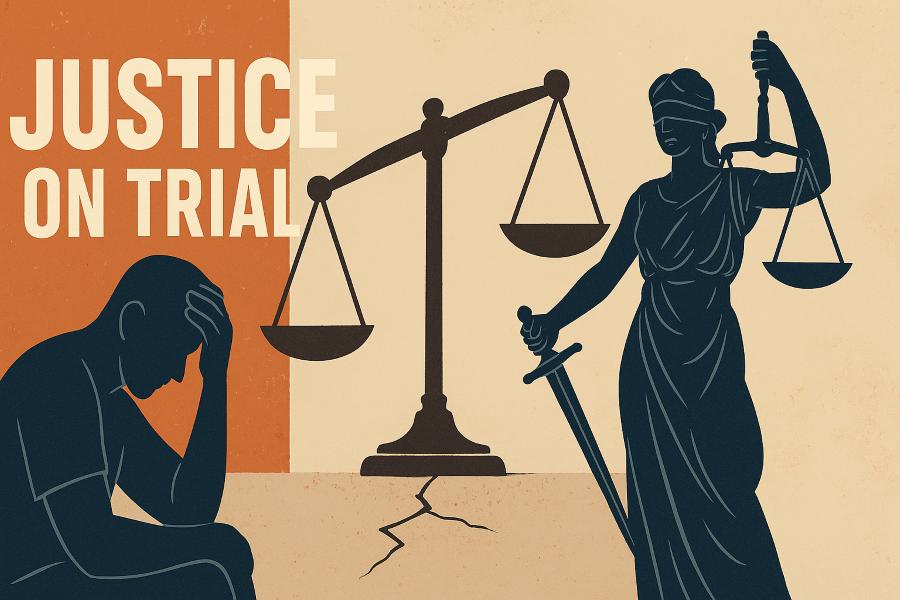Five crore pending cases and nearly nine lakh execution petitions show why India needs real reforms, not speeches.
SPEAKING AT THE National Conference on “Strengthening Legal Aid Delivery Mechanisms” to mark Legal Services Day, Prime Minister Narendra Modi said that ease of living and ease of doing business are possible only when ease of justice is ensured.
He also stated that when justice is accessible to all, delivered in a timely manner, and reaches every individual regardless of their social or financial background, “that is when it truly becomes the foundation of social justice.”

Prime Minister Modi with CJI Gavai and Justice Surya Kant at the Legal Services Day event, emphasising the urgent need for judicial reforms.
Chief Justice of India Bhushan R. Gavai, speaking at the valedictory function of the same conference a day later, also called for a “structural overhaul of the legal services authorities” in the country.
CJI-designate Justice Surya Kant, also speaking at the same event, underlined that the legal services framework in the country must now “move beyond widening its geographic footprint to ensuring deeper, measurable impact on the lives it seeks to transform.”
All these observations and comments are commendable, but the question remains: who has the capability to usher in these reforms? Surely not the common man. It can be done only by these very dignitaries.
The Indian legal services and justice delivery system is crying for justice, but no one seems willing to take responsibility and grasp the bull by its horns.
Despite repeated claims of judicial reform, the pendency of cases in various courts continues to mount. The number of pending cases in the courts is now estimated to exceed five crore. It is no secret that cases remain pending for years together, and sometimes it takes decades for verdicts to be delivered.

For countless litigants, the fight doesn’t end with a verdict—justice remains painfully out of reach.
The government continues to be the biggest litigant and needs to first put its own house in order. Public prosecutors often file review petitions to avoid personal responsibility or at the behest of the executive.
There appears to be no accountability for the huge wastage of time or the harassment caused to litigants due to long delays in the delivery of justice.
What’s more, even the delivery of a judgment is not the final relief for the common people.
Nationwide data collected at the behest of the Supreme Court last month revealed that over 8.82 lakh execution petitions were pending across various district courts in the country.
Thus, despite winning court cases after prolonged litigation, successful litigants have to wait endlessly to receive what the courts have already awarded them.
A Division Bench of Justices J.B. Pardiwala and Pankaj Mithal, which had ordered the survey, observed: “After the decree is passed, if it is going to take years and years to execute the decree, then it makes no sense and would be nothing short of a travesty of justice.”

Lady Justice without a blindfold, but the system remains the same.
The issue of decrees involves a tedious procedure, and for litigants it becomes a second round of litigation for the same relief that has already been granted by the courts. To implement a decree, successful litigants must file an execution petition, which can itself take years for enforcement of what has already been judicially decided.
According to data gathered by the National Judicial Data Grid, an average civil suit takes 4.91 years for disposal, while an execution petition takes an additional 3.97 years to conclude.
The data is indeed shocking. The delays are mainly attributed to non-availability of legal counsels, stays granted by higher courts, and discrepancies in documents.
The Supreme Court has now rightly directed all High Courts to follow up with their district courts and expedite the disposal of execution petitions within six months.
However, much more needs to be done to improve the judicial delivery system in the country. It is for the Prime Minister and the Chief Justice of India to take the lead in overhauling the justice delivery system—and not merely wish that it were done. ![]()
________
Also Read:
Disclaimer : PunjabTodayNews.com and other platforms of the Punjab Today group strive to include views and opinions from across the entire spectrum, but by no means do we agree with everything we publish. Our efforts and editorial choices consistently underscore our authors’ right to the freedom of speech. However, it should be clear to all readers that individual authors are responsible for the information, ideas or opinions in their articles, and very often, these do not reflect the views of PunjabTodayNews.com or other platforms of the group. Punjab Today does not assume any responsibility or liability for the views of authors whose work appears here.
Punjab Today believes in serious, engaging, narrative journalism at a time when mainstream media houses seem to have given up on long-form writing and news television has blurred or altogether erased the lines between news and slapstick entertainment. We at Punjab Today believe that readers such as yourself appreciate cerebral journalism, and would like you to hold us against the best international industry standards. Brickbats are welcome even more than bouquets, though an occasional pat on the back is always encouraging. Good journalism can be a lifeline in these uncertain times worldwide. You can support us in myriad ways. To begin with, by spreading word about us and forwarding this reportage. Stay engaged.
— Team PT

